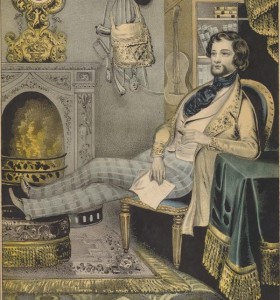
We began the new year with a teaser post on “Love and the Library” that introduced our new line-a-day subject, Nathan Beekley. We are now proud to debut the site based on Beekley’s diary for 1849, Clerk and the City . Beekley’s daily blog posts will appear in the sidebar on Past is Present, but you can read up on the first two weeks (including extensive extra illustrations and historical commentary on Beekley’s original entries) by visiting https://clerkandthecity.wordpress.com/.
The Clerk and the City blog is based on the hard work of two amazing interns at the American Antiquarian Society. Chelsea White transcribed the entire diary from the original in AAS’s manuscript collections and wrote last week’s post. Maury Bouchard has done a tremendous amount of additional research on our clerk in an iron factory, including actually mapping Nathan Beekley’s world.
To whet your appetite, here is an excerpt from the biographical sketch of Beekley written by our AAS intern, Maury Bouchard:
Nathan Beekley kept a diary for the whole of 1849 in which he describes an active social life including frequent calls upon young ladies whose names are obscured for propriety’s sake, and a thirst for knowledge. This is typical of young clerks working in the big city in the 1840s according to Brian P. Luskey, author of On the Make: Clerks and the Quest for Capital in Nineteenth-Century America (New York University Press, 2010). In one key area, however, Beekley does not fit Luskey’s model of a city clerk. Nathan, for one, does not appear to be very interested in financial advancement. At least he does not discuss his work very often in his diary. There is very occasional mention of being in the Counting House (of Reeves, Buck and Co, 45 N Water Street, manufacturers of nails and railroad iron) and one mention of asking for and receiving a raise to $500 per annum.
Young Mr. Beekley, though, has much to say on the cultural events of the day. We learn much about the plays, concerts, operas and other performances in his city. He is not reluctant to give his opinion of performances, good or bad. He attends church regularly, often two or three times on a Sunday. He appears to relish the sermons and he makes a point of attending lectures when the opportunity arises. He makes frequent trips to Norristown (six miles distant) where he lately worked in the “type-sticking business” and where he has many friends.
Mostly though, Beekley is looking for a wife. His diary is replete with references to young ladies he calls upon almost every day. Who are E____h S__d__n and F__y C___t and how do they feel about Nathan’s attentions? There are also the Misses West and MacKay and young female friends who pose as cousins to avoid raised eyebrows as they gain entrance to his lodgings. The life and loves of a mid-19th century iron clerk are not exactly Melrose Place-material, but remain fascinating none the less. [Continue reading]
We hope you will enjoy the fruit of our labors, and that you all have as much fun as we have getting to know this engaging young man on the make as he pursues love and culture on the streets of Philadelphia.

This is a great idea! I’ve blogged about it on my new “regular people’s history” site (http://www.regularpeopleshistory.com/RPH/blog.html ), and bookmarked it so I can come back to it regularly. What a cool opportunity to get a glimpse into the life of a regular guy in 1849! Thanks!!